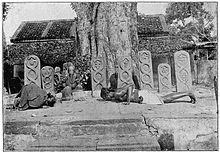Vellalar
| Vellalar | |
|---|---|
| வேளாளர் | |
| Classification | Farmers, Landlords, Chieftain |
| Religions | Saiva Siddhantam, Hinduism, Christianity |
| Languages | Tamil |
| Subdivisions | |
| Related groups | Tamil people |
| Notes | |
| ‡ Shared by other groups | |
Vellalar is a Tamil caste found mainly in the Indian states of Tamil Nadu, Kerala and in northeastern parts of Sri Lanka.[1] Their traditional occupation is agriculture also serving as landlords.[2] They were major patrons of literature in medieval era.[3] They were a dominant secular aristocratic caste who contributed as courtiers, army officers, lower ranks of the bureaucracy and upper layer of the peasantry.[4]
Etymology
The word Vellalar comes from the Tamil words, veḷḷam ("flood", "water" or "abundance") and āṇmai ("lordship" or "management"), thus the word literally mean "those who manage water" or "Lord of the floods" .[5][6]
History

They were traditionally a land owning community of South India, mentioned in Sangam literature along the Karalar as cultivators.[7][8] The Vellalar tribes were an important limb in the society of ancient Tamilakam in Sangam period and post-Sangam period. They were of two types, the cultivators called Velkudi Ulavar and the wealthy landowners called Kaniyalar or Kodikkalar.[9]
The Vellalar tribes are described as a landed gentry who irrigated the wet lands and the Karalar (use Vellalar as title) were the landed gentry in the dry lands. Karalar means "Lord of clouds".[10] Vellalar chieftains were responsible for state-level authority from at least 6th century AD to 12th century AD. They endowed Brahmins and non Brahmins with land.[11]
The Vellalar caste were in 1901 census placed by the Government of Madras as Sat-Shudra, meaning "Clean Shudras", the fourth category in the Varna system. However the Government of Madras recognized that the fourth folded varna system did not describe the Dravidian society adequately.[12]
In Post-Independent India too, it was noted that families regarded as pure Vellalar caste (Saiva Vellalars) were reluctant to question the bona fides of those pretending to be Vellalar, since the line between them was noted to be very thin indeed; with the former occasionally drawing partners for marriage from the ranks of the latter.[13]
In Kerala and Sri Lanka
The Vellalars of Sri Lanka have been chronicled clearly in the Yalpana Vaipava Malai and other historical texts of Jaffna kingdom. From the 13th century when migration of Vellalar chiefs to Jaffna took place, Tamil Nadu has seen a decline in the traditional power of Vellalars except in Kongu Nadu.[14]
Cultural evolution and assimilation of other castes
Most subcastes of Vellalar in general are believed to be the first of the group of Tamils to be Sanskritised.[citation needed]
Following the arrival of Dutch missionaries in the early 18th century, some Vellalar converted to Christianity.[15]
See also
References
- ^ Holt, John (13 April 2011). The Sri Lanka Reader: History, Culture, Politics. Duke University Press. ISBN 0822349825.
- ^ Ramaswamy, Vijaya (15 September 2017). Historical Dictionary of the Tamils. Rowman & Littlefield. ISBN 9781538106860.
- ^ Sen, Sailendrda Nath. Ancient Indian History and Civilization (2nd ed.). pp. 205, 207.
... the Vellalars were the aristocratic classe and were held in high esteem...
- ^ Gough, Kathleen (3 January 2008). Rural Society in Southeast India. Cambridge University Press. ISBN 9780521040198.
- ^ Kent, Eliza F. (1 April 2004). Converting Women: Gender and Protestant Christianity in Colonial South India. Oxford University Press. ISBN 9780198036951.
- ^ Journal of the Ceylon branch of the Royal Asiatic Society By Royal Asiatic Society of Great Britain and Ireland. Ceylon Branch, Colombo: "'Vellalar' is also said to be a contract form of 'Vella-Alar', meaning 'the lords of the Vellam', flood..."[1]
- ^ Al-Hind: Early medieval India and the expansion of Islam, 7th-11th centuries By André Wink pages 321: "Not only were the Vellalas the landowning communities of South India,..."[2]
- ^ Study, Indian Institute of Advanced (1 January 1997). From tribe to caste. Indian Institute of Advanced Study.
- ^ History of People and Their Environs: Essays in Honour of Prof. B.S. Chandrababu. Indian Universities Press. 2011. ISBN 9789380325910.
- ^ India's Communities. Oxford University Press. 1998. ISBN 9780195633542.
- ^ Moffatt, Michael (8 March 2015). An Untouchable Community in South India: Structure and Consensus. Princeton University Press. ISBN 9781400870363.
- ^ Price, Pamela G. (14 March 1996). Kingship and Political Practice in Colonial India. Cambridge University Press. ISBN 9780521552479.
- ^ Encyclopaedia of the Theoretical Sociology (3 Vols. Set), by A.P. Thakur, p.182: "Even families who might be regarded as of 'pure' Vellalar caste are reluctant to question the bona fides of the Vellalar 'pretenders' since the line between them is very thin indeed [3]."
- ^ Yalpana Vaipava Malai Archived 30 September 2007 at the Wayback Machine
- ^ Etherington, Norman, ed. (2005). Missions and Empire. Oxford University Press. p. 112. ISBN 978-0-19153-106-4.
Further reading
- Lucassen, Jan; Lucassen, Leo (2014). Globalising Migration History: The Eurasian Experience. BRILL. ISBN 978-9-00427-136-4.
